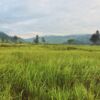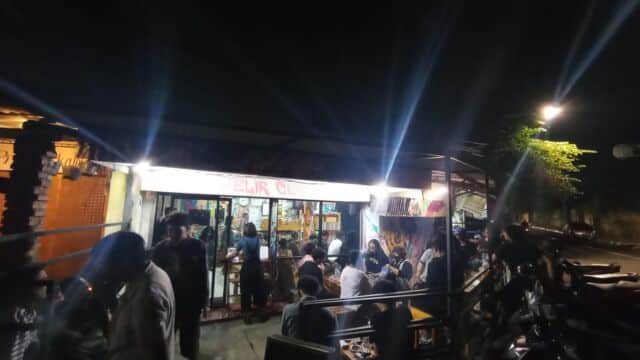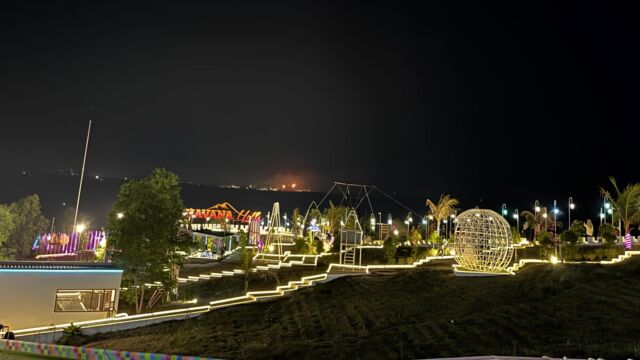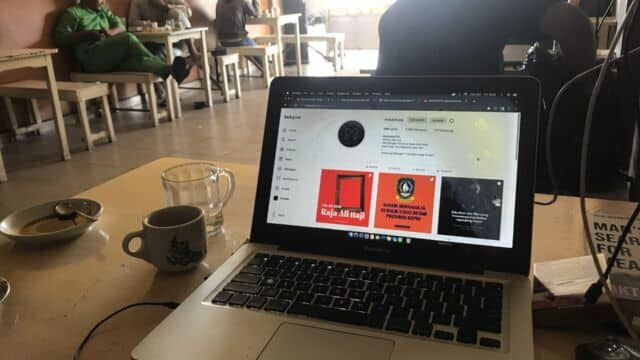This Is What An Escape To The Country Looks Like In Indonesia
Photo: Bagaskoro Dwi/Unsplash
A plot of land in the foothills of Merapi | 2000 words
Translated from Bahasa Indonesia by Dan Benjamin
‘Where ya goin?’
It was our very first time on the road to Kaliwanglu Wetan. The strip of bitumen heading towards the village was flanked by wide expanses of ricefields dotted intermittently with chilli plants; coconut, banana, and papaya trees had been planted along the edges of each paddy. Finches flitted between the greenery.
I, who was driving the motorbike, and my wife, who sat behind me on the bike seat cradling our toddler, found ourselves struggling to answer. Apart from the bike’s engine still puttering loudly, we were a little shy about blurting out that we were heading to a nearby plot of land we had just bought. Quickly, I thought of a coffee-shop I knew to be at the end of this road. I turned off the motor, then said its name with a belated appraising glance at the man who had asked. He looked confused by this answer – there are other roads which are wider and offer far easier travel to that café.
Entering the village proper, we passed several houses on the road’s left-side. To the right was still ricefields. The same question got yelled out several times as we drove on. I guess they suspected we were lost: we were, after all, on a road that only leads to farming land and scattered houses. Other vehicles were a rare sight. Finally, we decided to take the next opportunity when asked the question to stop and be up-front about our purposes and our ultimate destination, which was now not far away at all.
As it turned out, the locals warmly welcomed us. Pak Mursyid, a 57 year old construction worker, asked where we were from, our jobs, and the age of our child. We replied: I was from Cirebon, West Java, and my wife was from Boyolali, Central Java; I was a lecturer at the University of Gadjah Mada and my wife was a teacher; and our child would be two years old in May. He asked when we planned to build our house and whether we would need any help, then pointed out the house of the kepala desa and ketua RT, neighbourhood-level leadership positions, so we could soon complete the administrative particulars of becoming a ‘citizen’ of the village.
We felt very grateful to be becoming their neighbours and to be living in an environment that was ‘guyup’, a Javanese word for harmonious – something we might not have obtained if we had bought a house in one of the gated communities or suburban housing developments that are popping up everywhere here in Yogyakarta.
People who move into those sort of new housing estates find themselves cut off from surrounding neighbourhoods, even if they’re so close as to technically be in the same kampung. There’s always a fence circling those developments which limits outsiders from entering the grounds. As a result, those living within the gates and those living outside don’t get to know each other. Residents of the estates tend to be overly individualistic and grasp tightly to their privacy, even as the locals outside hold onto the older values of community, fraternity and cooperation encapsulated by the Javanese phrase ‘guyup rukun’.
The sharp separateness between residents of new housing estates and surrounding communities prompted a friend to give us some blunt advice when, initially, we were considering moving into the former:
‘Look, before you buy into one of these places, ask first the village officials in that area – if you die there, do you have the right to be buried there? Sorry, I don’t mean to scare-monger, but you need to be aware of this issue because it’s really happening – residents of private housing developments who die are being denied permission to be buried in the locality.’
On the balcony of our house we’ll entertain every guest who visits with the view of Mount Merapi to the north and the babble of water flowing to the south, accompanied by a cup of tea or coffee while we swap all sorts of stories. We can’t wait to live there.
Originally, we planned to just buy a house without thinking inordinately about its construction, preferring not to torment ourselves with debating what materials to use and supervising workers and so on. But after seeing designs of houses for sale which were all more or less identical, as if from some uniform template, and realising that we wanted a house with a more unique design, we decided to buy a piece of land instead, then employ an architect to design and build a home on top of it. Although buying land here is roughly as hard as buying a house, we finally got ourselves a plot in Kaliwanglu Wetan, about a half hour from central Yogyakarta.
At least once every three days we visit our land – if not in the morning then in the late afternoon, depending on the weather. I like to stand there and gaze at Mount Merapi 20 kilometres to the north, the most active volcano in Indonesia, 2,930 metres above sea level. This mountain is often the inspiration or object of artistic work in Indonesia, in literature, painting, photography and film. Particularly if there’s a clear blue sky, Merapi looks wonderful.
My wife, meanwhile, is drawn more to listening to the steadily-flowing water channel that trickles through here. The sound of water in these channels calms the mind, so they say. It’s really just your garden-variety ditch of the type that criss-crosses rural villages and irrigates ricefields across Southeast Asia. But because this place is so quiet, the babble of the running water produces a continuous sound that’s almost rhythmic.
To the west of our plot is a semi-tended semi-wild landscape, covered in long grass and leaf litter and dotted with banana-trees – in Bahasa Indonesia this type of terrain is called pekarangan. To the north and east are ricefields. The sound of insects can be heard in the mornings. In the afternoons, even human activities make less noise than the swish of the rice-plants being blown back and forth in the wind.
For us, living close to ricefields is a blessing. It’s not merely that it reminds us of our childhoods in Cirebon and Boyolali, where we often played in the rice, but also about the revitalising effect on our psyches of the tranquility of such scenery – that our eyes can go to the horizon and see nothing but ricefields. When we rented a place in Ngaglik in north Yogya, immediately in front of our house was a chicken-coop, while to the right and left were the walls of neighbours. Hard to ‘broaden your horizon’, so to speak, in a place like that. That rental was close to a busy road as well which produced incessant noise.
While there’s indeed a road in front of our new plot of land, it’s not exactly a major thoroughfare. It turns out though that this road is used as a bike-path on weekends and public holidays by lots of bike-riders. I see them often as they stop to take a photo of Merapi or a selfie with Merapi in the background. Aside from the scenery, they likely take this path because it’s so empty of traffic. Cars are very rare. Even motorbikes don’t pass often. The road really only gets used by locals, their guests, bike-riders, and people sent in the wrong direction by GoogleMaps.
Like the surrounding areas which make up the foothills of Mount Merapi, the air here really is fresh, especially at night. One time I was checking out our land after dark, to make sure the surrounding street-lights are sufficiently bright, when I found that my motorbike seat – which I’d left only momentatily – was already damp, even though it wasn’t so much as drizzling.
We never imagined we could get a piece of land like this, with so many pleasures. And the price wasn’t so terrible. In other areas the price of land can go dramatically up because of the existence of popular coffee-shops close by, but here that hasn’t happened, even though there are four good coffee shops around. One of them’s very popular indeed, so much so that when we want to tell friends exactly where we’ve bought, after a couple of attempts trying to describe the geography, we just say, ‘Close to Kopi 12’. Immediately they nod in recognition.
So yeah, I should say that Yogyakarta is now well-known for hosting a dynamic coffee scene with hundreds of coffee shops, so many, in fact, that there’s a saying: ‘In Jakarta people spend their time stuck on the roads, but in Yogyakarta time gets brewed in coffee-shops’. I’m one of those people who regularly ‘brews’ his time in coffee shops – including when writing this essay. But in the future will I be a regular at the ones close to this land, to meet friends or write? Nup.
We’re going to host our friends in the house we’ll build. For what is this new house for if not for entertaining? And I’m going to get a lot of writing done on the top floor, where there’s going to be a balcony. There I won’t endure the constant temptations of kissing my child or hugging my wife which I often experience now in our rental because I’m not able to keep a distance from them while I’m at work.
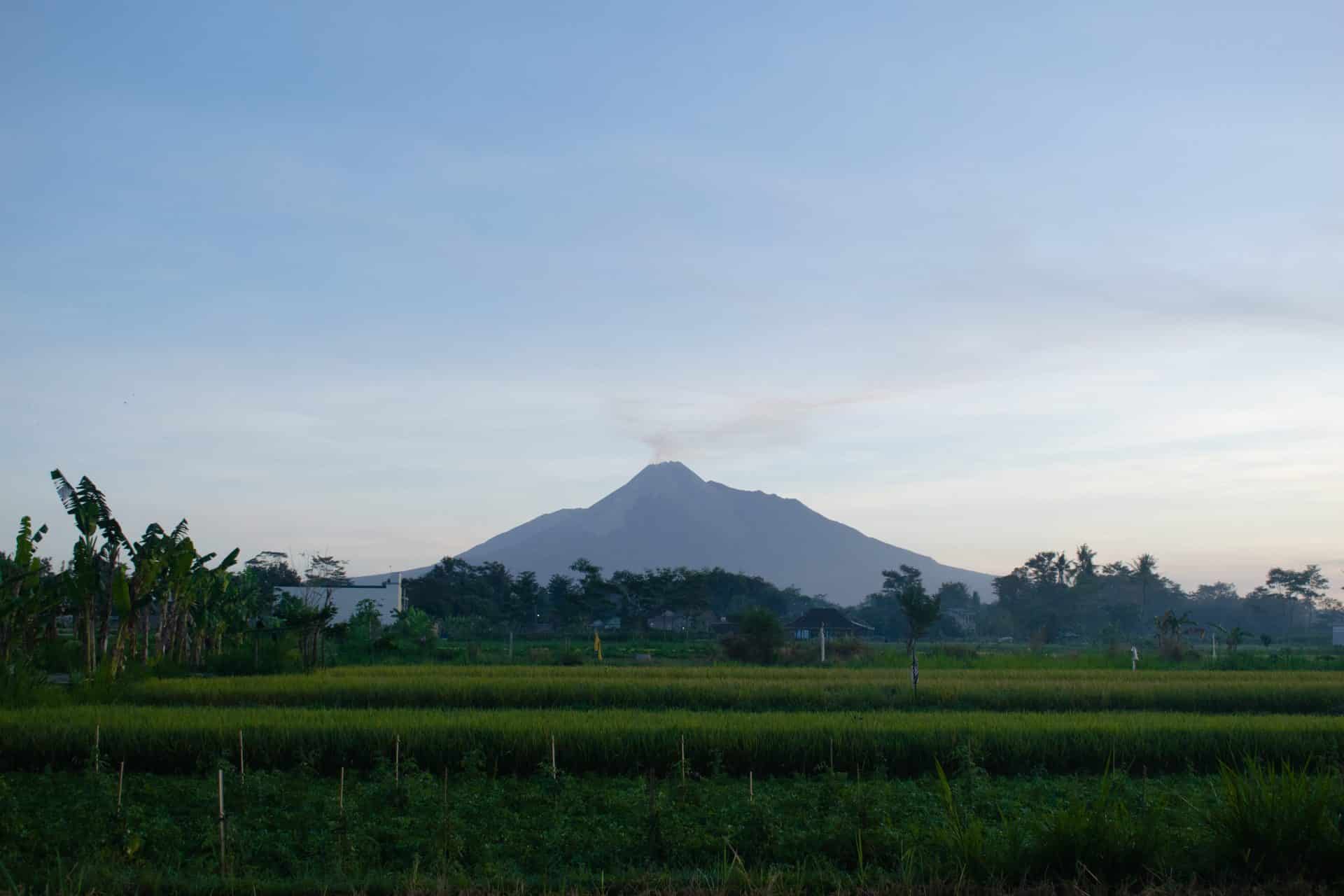
Now, this house we’re going to build will have a lot of open space to maximise light and get some good breezes flowing through. How lousy would it be if our house was closed-up even though the air here is so fresh? How lousy would it be, also, if the surrounding land was covered up by concrete and buildings, even though it’s so fertile and plants grow so well? Properties being sold in Yogya now generally offer little if any green space: some are 100% surrounded by concrete. They have small windows and poor ventilation, and feel dark and stuffy. Instead of creating space that maximises natural light and air, they depend overly on electricity to power AC units and lots of lights. That, of course, is extremely bad for the environment.
Along with friendly neighbours and beautiful scenery, one more thing we’re thankful for getting is a pro-environment architect. He’s shrewd at utilizing a lot of recycled materials when he builds houses. He’s also planning for our house to take up less than 50% of our land. The rest will be a garden which we hope to plant with mango and soursop together with several types of flowers like jasmine, Asian pigeonwings, and kardable.
But what really made me fall in love with the floor-plan was that there are big windows on the second-floor. From those windows we’ll be able to look out at Merapi whenever the weather’s clear. Something we most definitely can’t do from the centre of Yogyakarta, which is so filled with high concrete structures that the view to Merapi is almost always obstructed.
One of the moves of Wiro Sableng, a fictional warrior and master of Indonesia’s ‘silat’ form of martial arts, was called ‘Opening The Window And Spearing The Moon’, which he used when facing a particularly fierce opponent. I shall be mastering the move of ‘Opening The Window And Gazing At Merapi’ – not to defeat any bad guy, but to drive away burnout. Meanwhile my wife has her eye on a room that has a window facing the water channel. She’s already imagining the sound of the gently-running stream as a lullaby sending her off to sleep at night.
On the balcony of our house we’ll entertain every guest who visits with the view of Mount Merapi to the north and the babble of water flowing to the south, accompanied by a cup of tea or coffee while we swap all sorts of stories.
We can’t wait to live there.
© Asef Saeful Anwar
English translation © Dan Benjamin



